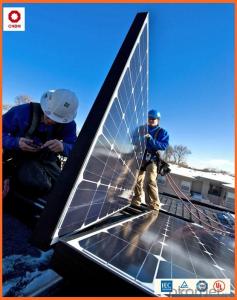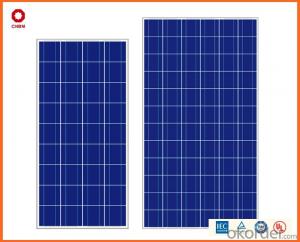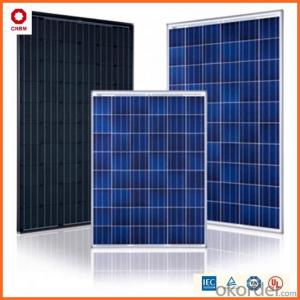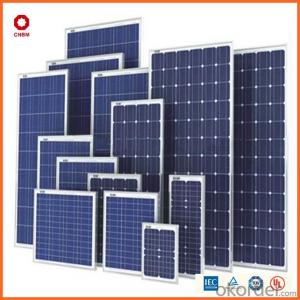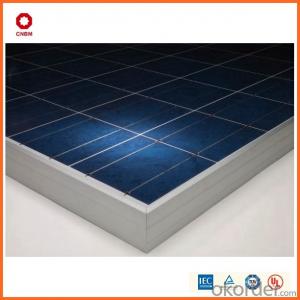Stock 305w Poly Solar Panel 0.46/W A Grade Good Solar Panel on Sale
- Loading Port:
- China main port
- Payment Terms:
- TT OR LC
- Min Order Qty:
- 1 watt
- Supply Capability:
- 10000000 watt/month
OKorder Service Pledge
OKorder Financial Service
You Might Also Like
Item specifice
Hot Sale !!! Quality and Safety of 245w-320w Poly Solar Panel
1. Rigorous quality control meets the highest international standards.
2. High-transmissivity low-iron tempered glass, strong aluminium frame.
3. Using UV-resistant silicon.
4. IS09001/14001/CE/TUV/UL
Warranties of 245w-320w Poly Solar Panel
1. 10 years limited product warranty
2. 15 years at 90% of the minimal rated power output
3. 25 years at 80% of the minimal rated power output
Technical date of 245w-320w Poly Solar Panel
Specification
Characteristics of Poly solar panels CNBM (245-320W) | |||||
Max Power Voltage Vmp(V) | 30.3 | 30.8 | 31.1 | 31.4 | 31.85 |
Max Power Current Imp(A) | 7.60 | 7.64 | 7.73 | 7.81 | 7.85 |
Open Circuit Voltage Voc(V) | 36.1 | 36.6 | 37 | 37.3 | 37.68 |
Short Circuit Current Isc(A) | 8.50 | 8.55 | 8.65 | 8.75 | 8.85 |
Max Power Pm(W) | 230W | 235W | 240W | 245W | 250W |
Temperature Coefficient of Cells Poly solar panels CNBM (245-320W) | |
NOCT | 45 ± 2 |
Temperature Coeffucients of Isc | 0.0492 |
Temperature Coeffucients of Voc ( | -0.3374 |
Temperature Coeffucients of Voc | -0.4677 |
Mechanical Data of Poly solar panels CNBM (245-320W) | |
Dimension | 1638 × 982 × 40 mm |
Weight | 19.5 kg |
No. of Cells and Connections | 60 (6 ×10) |
Tolerance | 0 ~ + 5 W |
Cell | Monocrystalline Cell 156 × 156 mm |
Packing | 624 Pcs/40ft(H) Container |
Limits of Poly solar panels CNBM (245-320W) | |
Operating Temperature | -4 0to +85 |
Storage Temperature | -40to +85 |
Max System Voltage | 1000VDC(IEC) / 600VDC(UL) |
Features of our products:
• High conversion efficiency mono/poly-crystalline amorphous silicon solar cells
• Modules incorporate high performance bypass diodes to minimize the power drop caused by shading
• High transmittance, low-iron tempered glass
• High performance EVA encapsulant to prevent destroying and water.
• AI frame: without screw, corner connection. 8 holes on the frame can be installed easily
• Good performance of preventing from atrocious weather such as wind and hails
• Certifications: CE IEC TUV VDE UL, Class I
• 10 years 90% power output warranty

- Q:Are there any disadvantages to using solar energy systems?
- Yes, there are a few disadvantages to using solar energy systems. Firstly, the initial installation cost can be high, making it less affordable for some individuals or businesses. Secondly, solar panels require a significant amount of space, which may not be feasible for those with limited roof or land area. Additionally, solar energy production is dependent on weather conditions, meaning it may not be as consistent or reliable as other energy sources. Finally, the manufacturing process of solar panels can have some environmental impact, especially in terms of energy consumption and waste generation. However, despite these drawbacks, the long-term benefits of using solar energy, such as cost savings, renewable nature, and reduced carbon emissions, often outweigh these disadvantages.
- Q:Can a solar energy system be installed in an apartment or rental property?
- Yes, a solar energy system can be installed in an apartment or rental property. However, the installation process may vary depending on the building's structure and landlord's permission. Renters can explore options like community solar programs, portable solar panels, or negotiating with their landlord for a solar installation.
- Q:Can solar energy systems be used for water purification?
- Yes, solar energy systems can be used for water purification. Solar-powered water purification systems utilize the energy from the sun to power various processes like filtration, disinfection, and desalination, making it an environmentally friendly and sustainable solution for clean water production.
- Q:What happens to a solar energy system during a power outage?
- During a power outage, a solar energy system will typically shut down automatically to protect both the system and the utility workers fixing the power grid. This is because solar energy systems are grid-tied and rely on the utility grid to function. However, there are some exceptions where solar energy systems equipped with battery storage can continue providing power during an outage, allowing the user to have electricity for essential appliances or even power their entire home.
- Q:Are there any financial incentives for installing solar energy systems?
- Yes, there are several financial incentives available for installing solar energy systems. These incentives vary by country and region but can include tax credits, grants, rebates, and net metering programs. Additionally, installing solar panels can help reduce electricity bills and increase property value, resulting in long-term financial benefits.
- Q:How does the tilt of solar panels affect their performance?
- The tilt of solar panels plays a significant role in determining their performance and overall efficiency. The optimal tilt angle for solar panels depends on various factors such as geographical location, season, and application. The primary reason why the tilt angle is crucial is to maximize the amount of sunlight that the solar panels can capture. Solar panels work by converting sunlight into electricity, and the angle at which they are tilted affects the amount of sunlight they receive. In general, solar panels generate the most electricity when they are perpendicular to the sun's rays. This means that during the peak hours of sunlight, panels tilted at an optimal angle will receive the maximum solar radiation. If the angle is too steep or too shallow, the amount of sunlight that the panels can capture decreases, thus reducing their performance. The optimal tilt angle also varies depending on the season. In summer, when the sun is higher in the sky, a steeper tilt angle may be more suitable to capture maximum sunlight. In contrast, during winter, a shallower tilt angle can help ensure that the panels receive sunlight even with lower sun angles. Geographical location is another crucial factor that influences the tilt angle of solar panels. The closer a location is to the equator, the less variation there is in the sun's angle throughout the year. Therefore, the optimal tilt angle for solar panels may be closer to the latitude of the location. For example, in equatorial regions, solar panels are often mounted nearly flat to maximize their exposure to the sun's rays. In addition to maximizing sunlight exposure, the tilt angle also affects the self-cleaning capability of solar panels. Rainfall can help wash away dirt and debris from the panel's surface, preventing the buildup of grime that can reduce their efficiency. A proper tilt angle can facilitate the natural cleaning process by allowing rainwater to flow down the surface more effectively. In summary, the tilt angle of solar panels directly affects their performance. With the right tilt angle, solar panels can capture the maximum amount of sunlight, leading to higher electricity generation. Considering the geographical location, season, and desired performance, it is crucial to determine an optimal tilt angle to maximize the efficiency and overall output of solar panels.
- Q:Solar photovoltaic system
- To search and collect profit (in all spontaneous terms): the average recovery of funds on average generating capacity = * (distributed generation electricity subsidies + residential electricity price =200* (0.42+0.55) =194 were the first year of the recovery of funds = daily recovery funds *365=194*365=70810 yuan investment recovery period = total investment / average recovery of funds is about =450000/70810=7.06 years. 6.5 years 25 years average annual net income = recovery funds * (20 -6.5) + daily average generation price *365 * electricity days *5 years =70810*13.5+200*0.55*365*5=1156680 yuan
- Q:Can a solar energy system be installed on a parking garage or structure?
- Certainly, it is entirely possible to install a solar energy system on a parking garage or structure. As a matter of fact, these locations are often considered ideal for solar installations due to their expansive surface areas and access to sunlight. The utilization of available space can be maximized by mounting solar panels on the roof or external walls of parking structures. Furthermore, the raised position of parking garages enables better exposure to sunlight, resulting in more efficient generation of solar energy. Furthermore, the installation of a solar energy system on a parking garage or structure can yield numerous advantages, including the generation of clean and renewable energy, reduction in electricity costs, and offsetting of carbon emissions. This choice therefore proves to be a sustainable and environmentally friendly option for energy production.
- Q:How does solar energy compare to other renewable energy sources?
- Solar energy is often considered one of the most accessible and abundant renewable energy sources. Unlike wind or hydroelectric power, solar energy can be harnessed virtually anywhere, making it widely applicable. Additionally, solar panels have a long lifespan, require minimal maintenance, and produce no greenhouse gas emissions during operation. While solar energy may have limitations in terms of efficiency and intermittency, it remains a promising and increasingly competitive alternative to other renewable energy sources.
- Q:Can solar energy systems be used for powering wastewater treatment plants?
- Absolutely, wastewater treatment plants can definitely utilize solar energy systems for power. To generate electricity, solar panels and other solar energy systems can be installed on the rooftops or in open areas surrounding the treatment plants. This generated electricity can then be utilized to power the various components and processes involved in wastewater treatment, including pumps, motors, blowers, and filtration systems. Using solar energy for wastewater treatment plants brings several advantages. Firstly, it is an environmentally friendly and sustainable energy source, helping to reduce the carbon footprint and environmental impact of these facilities. Solar energy systems produce electricity without releasing any greenhouse gases or pollutants into the air, making them an excellent choice for preserving the environment. Secondly, solar energy systems can provide a consistent and dependable power supply to the treatment plants. The availability of sunlight is generally predictable, and advancements in solar technology have enabled the storage of excess energy in batteries for use during cloudy days or at night. This ensures uninterrupted operation of the wastewater treatment plants, even in areas with unreliable grid connections or frequent power outages. Moreover, solar energy systems can also contribute to cost reduction for wastewater treatment plants. By generating their own electricity, these facilities can potentially decrease their reliance on the grid, resulting in substantial savings on energy bills. Additionally, solar energy systems require minimal maintenance and have a long lifespan, leading to further cost savings over time. In conclusion, solar energy systems can be effectively utilized for powering wastewater treatment plants. They provide a clean, dependable, and cost-effective solution that not only reduces the environmental impact but also offers energy independence to these crucial facilities.
1. Manufacturer Overview |
|
|---|---|
| Location | |
| Year Established | |
| Annual Output Value | |
| Main Markets | |
| Company Certifications | |
2. Manufacturer Certificates |
|
|---|---|
| a) Certification Name | |
| Range | |
| Reference | |
| Validity Period | |
3. Manufacturer Capability |
|
|---|---|
| a)Trade Capacity | |
| Nearest Port | |
| Export Percentage | |
| No.of Employees in Trade Department | |
| Language Spoken: | |
| b)Factory Information | |
| Factory Size: | |
| No. of Production Lines | |
| Contract Manufacturing | |
| Product Price Range | |
Send your message to us
Stock 305w Poly Solar Panel 0.46/W A Grade Good Solar Panel on Sale
- Loading Port:
- China main port
- Payment Terms:
- TT OR LC
- Min Order Qty:
- 1 watt
- Supply Capability:
- 10000000 watt/month
OKorder Service Pledge
OKorder Financial Service
Similar products
New products
Hot products
Related keywords
